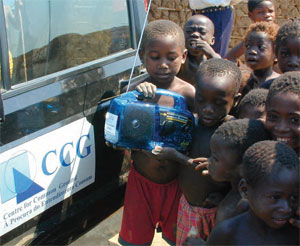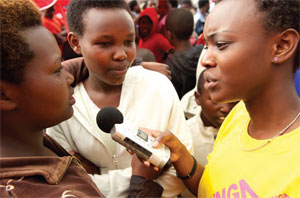Pop Culture for Peace
Mass media as a method for healing
Believing that popular culture is among the most useful tools for modeling conflict resolution, Search for Common Ground (SFCG) creates education disguised as entertainment. It began with a radio soap opera in Burundi in the late Nineties called “Our Neighbors, Ourselves.” The program depicted two families—one Hutu, the other Tutsi—who peacefully resolved disputes over the course of 616 episodes; on ABC’s “Nightline,” Ted Koppel called it “the voice of hope.” In the years since, Common Ground Productions has made TV series (both dramas and documentaries), talk shows, radio programming, music videos, and public service announcements, including one by Jamaican reggae star Ziggy Marley promoting peace in Burundi. “Every culture has a storytelling tradition,” says SFCG founder and president John Marks ’65. “We try to take advantage of that to change values and attitudes.”

For instance, in the Democratic Republic of Congo—where more than 200,000 women and girls have been raped over the past decade, primarily by the Congolese Army and armed militias—SFCG distributed 200,000 comic books portraying model behavior by soldiers. In Albania, Kosovo, and Macedonia, children can watch “Nashe Maalo” (“Our Neighborhood”), co-produced by Common Ground Productions in association with the Children’s Television Workshop and set in an ethnically mixed apartment building. The children there know a secret: the building is alive, communicating through a TV set in the basement and acting as a sort of Delphic Oracle to steer them toward the right path. “The Station,” a drama set in a fictional newsroom, addresses issues affecting Nigerians, from corruption to AIDS. The principal characters were cast through a reality TV program; thousands of would-be actors auditioned, creating buzz for both shows.
The organization’s flagship program—now produced and developed in seventeen countries—uses sports to transform social behavior. “The Team” was spawned when an intern walked into Marks’s office in 2006 and asked what SFCG was planning for the globe’s top sporting event, the World Cup. “Nothing,” Marks answered, “but that’s a great idea.” The conversation led to a serialized tale about a soccer team (in Pakistan, it’s a cricket squad) rife with enriching messages. “The only way to win is to cooperate and play together as a team; it’s a metaphor for the countries,” says Marks. “It’s soap opera for change.”

The first series, produced in Kenya after widespread tribal fighting followed a disputed election, focuses on promoting nonviolence and national pride. Penned by writers from various tribes, it follows the adventures—on and off the field—of a co-ed, multiethnic squad aiming for a national championship. The show became one of Kenya’s ten most popular programs, and its success spurred new funding and nation-specific versions across Africa and parts of the Middle East. The societal challenges are unique to each location, and the storylines reflect that. In Côte d’Ivoire, the team must confront divisions arising between the Christian south and the Muslim north; in Congo, an all-female team deals with gender issues and sexual violence; the Moroccan version explores the gulf between rich and poor. Each program provides a platform for Search for Common Ground to tailor its message. Mobile cinemas draw large audiences for communal viewings, often followed by meetings that bring together dozens of tribal leaders. As the coach reminds his players in the Kenyan pilot episode: “This is a team, not a battleground.”
Many of the CAM stories written by contributing editor Brad Herzog '90 through the years can be found at www.bradherzog.com.


